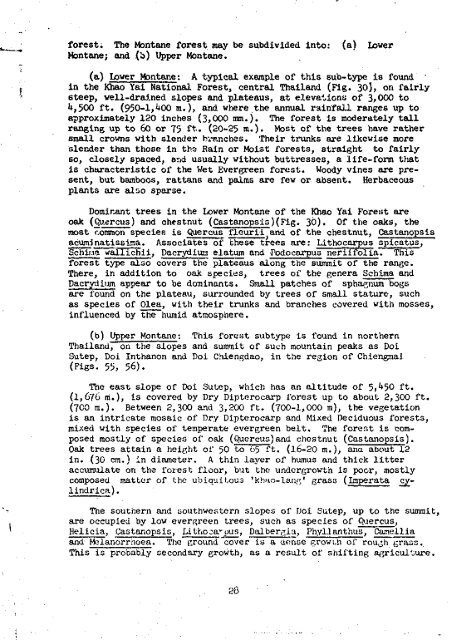Vegetation of Southeast Asia Studies of Forest Types 1963-1965
Vegetation of Southeast Asia Studies of Forest Types 1963-1965
Vegetation of Southeast Asia Studies of Forest Types 1963-1965
You also want an ePaper? Increase the reach of your titles
YUMPU automatically turns print PDFs into web optimized ePapers that Google loves.
forest; The Montane forest may be subdivided into: (a) Lower<br />
Montane; and .(b) Upper Montane.<br />
(a) Lover Montane; A typical example <strong>of</strong> this sub-type is found '<br />
in the Khao Yai National <strong>Forest</strong>, central Thailand (Fig. 30), on fairly<br />
steep, veil-drained slopes and plateaus, at elevations <strong>of</strong> 3,000 to<br />
U,500 ft. (950-1,1*00 m.), and where the annual rainfall ranges up to<br />
approximately 120 inches (3,000 mm.). The forest is moderately tall<br />
ranging up to 60 or 75 ft. (20-25 ra.). Most <strong>of</strong> the trees have rather<br />
small crowns with slender branches. Their trunks are likewise more<br />
Slender than those in ths Rain or Moist forests, straight to fairly<br />
so, closely spaced, and usually without buttresses, a life-form that<br />
is characteristic <strong>of</strong> the Wet Evergreen forest. Woody vines are present,<br />
but bamboos, rattans and palms are few or absent. Herbaceous<br />
plants are also sparse.<br />
Dominant trees in the Lower Montane <strong>of</strong> the Khao Yai <strong>Forest</strong> are<br />
oak (Quercus) and chestnut (Castanopsis)(Fig. 30). Of the oaks, the<br />
most common species is Quercus flourii and <strong>of</strong> the chestnut, Castanopsis<br />
acumjnatissirsa. Associates <strong>of</strong> these trees are: Llthocarpus spicatus,<br />
Schina tfallichii, Dacrydium elatum and •Podocarpus neriifolia. This<br />
forest type also covers the plateaus along the summit <strong>of</strong> the range.<br />
There, in addition to oak species, trees <strong>of</strong> the genera Schima and<br />
Pacrydium appear to be dominants. Small patches <strong>of</strong> sphagnum bogs<br />
are found on the plateau, surrounded by trees <strong>of</strong> small stature, such<br />
as species <strong>of</strong> Plea, with their trunks and branches covered with mosses,<br />
influenced by the humid atmosphere.<br />
(b) Upper Montane: This forest subtype is found in northern<br />
Thailand, on the slopes and summit <strong>of</strong> such mountain peaks as Doi<br />
Sutep, Doi Inthanon and Doi Chiengdao, in the region <strong>of</strong> Chiengraai<br />
(Figs. 55, 56).<br />
The east slope <strong>of</strong> Doi Sutep, which has an altitude <strong>of</strong> 5,^50 ft.<br />
(1,676 m.), is covered by Dry Dipterocarp forest up to about 2,300 ft.<br />
(700 ra.). Between 2,300 and 3,200 ft. (700-1,000 m), the vegetation<br />
is an intricate mosaic <strong>of</strong> Dry Dipterocarp and Mixed Deciduous forests,<br />
mixed with species <strong>of</strong> temperate evergreen belt. The forest is composed<br />
mostly <strong>of</strong> species <strong>of</strong> oak (Quercus)and chestnut (Castanopsis).<br />
Oak trees attain a height <strong>of</strong> 50 to 65 ft. (16-20 m.), ana about 12<br />
in. (30 cm.) in diameter. A thin layer <strong>of</strong> humus and thick litter<br />
accumulate on the forest floor, but the undergrowth is poor, mostly<br />
composed matter <strong>of</strong> the ubiquitous 'khno-lan^1 grass (Imperata cylindrica).<br />
The southern and southwestern slopes <strong>of</strong> Doi Sutep, up to the summit,<br />
are occupied by low evergreen trees, such as species <strong>of</strong> Quercus,<br />
Helicia, Castanopsis, lAtho-arpus, Dalbergia, PhyLlanthus, Camellia<br />
and Molanorrhoea. The ground cover is a dense fjrowt.h <strong>of</strong> roujh grass.<br />
This is probably secondary growth, as a result <strong>of</strong> shifting agriculture.
















